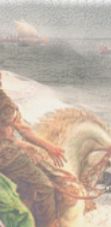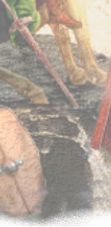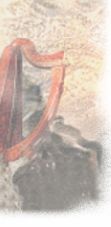 HOME
HOME
 |
 |
 |
 |
 |
 |
 Our Brian Boru is available for purchase
as an AnachronTM, Poster, Spirit Stone, Pendant, "Art-to-Wear" and more... please visit
Our Brian Boru is available for purchase
as an AnachronTM, Poster, Spirit Stone, Pendant, "Art-to-Wear" and more... please visit ![]() to view the entire collection.
to view the entire collection.
. . . . . . . . . . . . .
![]() We also have an extensive Celtic
Collection, with a lot of interesting information.
We also have an extensive Celtic
Collection, with a lot of interesting information.
In doing research for this series of artwork, I came across a lot of interesting material on the web. I'm happy to pass some of the best along to you in the links below.
. . . . . . . . . . . . .

High King of Ireland
Brian Bórumha mac Cennétig (known as Brian Boru in English) was for a brief, shining moment—like the legendary King Arthur—High King of a unified land and, like Arthur, his life story is cloaked in myth and mist, with few facts. But Brian was very real. Born in around 940 AD near Killaloe (Kincora), now County Clare, his father was Cennétig mac Lorcáin, King of Thomond and his mother was Bé Binn ingen Murchada, daughter of the King of West Connacht.
Throughout his childhood, the Irish were living in constant fear of Viking invasions. When Brian was still a young boy, the dreaded Norsemen invaded while he and his brother Mahon were out hunting.They returned to discover the castle burned and nearly everyone killed, including their mother. This horrific experience affected him greatly and he responded by rebelling against authority, focusing only on how to avenge his family. He was eventually sent away to a monastery school where he channeled his energies into learning about the Vikings. He also learned to love learning itself and became adept at Latin and Greek. Through studying the history of Ireland, Brian realized that virtually every neighborly dispute turned into a war.
He decided that the Irish should stop fighting among themselves and unite against their common enemy, the Norsemen. Mahon had by now succeeded to the throne of Munster, Cashel, (Tipperary). He joined forces with Brian and they defeated the Limerick Vikings, bringing a long period of peace to southern Ireland.
But after a decade, the Norsemen regrouped with a vengeance, assassinating Mahon in the process. Brian succeeded him to the throne, carrying in his heart a rekindled hatred. Even so, King Brian’s influence continued to grow as he rebuilt churches and promoted diplomacy and harmony among the tribes. His popularity, power and influence grew so strong that King Malachy in the north relinquished his crown to Brian, making him Ard Ri of Tara (High King of Ireland) in 1002.
Relations with the Norse did not improve, however, and Brian’s rivals were many. Maelmordha, King of Leinster, revolted and recruited the Vikings who had long been living in Ireland. They formed a coalition of Brian’s Irish enemies, as well as forces from the Hebrides, the Orkneys, and Norse countries.
On Good Friday, 1014, Brian's warriors defeated the allies at Clontarf, near Dublin. Sadly, soon afterward he was assassinated in his own tent. Brian's victory broke the Norse power in Ireland forever, but without his unifying influence, Ireland soon fell back into infighting. Known as the progenitor of the Clan O'Brien, his legacy is a reminder of the strength of a unified Ireland. The national emblem of the harp is named after him (on display at Trinity College). The evocative traditional tune, “Brian Boru’s March” is played everywhere on everything from pipes to harp.

Borian
Boru March Click to listen to
MP3 now
The O'Brien Clan
official site also offers an MP3 of "Brian's Song"
as well as a lot of other good stuff.
The
Brian Boru, or Trinity College harp
is probably the oldest intact wire-strung frame harp in existence. It is the national symbol of Ireland, and is
depicted on coins, passports and all Government documents.
Brian Boru from The Irish Storyteller
Brian Ború was crowned King of Munster here in 977 and he became High King of Ireland in 1002.

All images and words produced by PatriArtsTM are ©copyrighted and may not be reproduced, copied, downloaded or duplicated in any way without expressed permission.